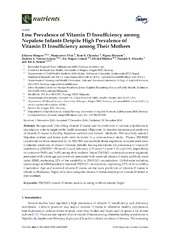| dc.contributor.author | Haugen, Johanne | en_US |
| dc.contributor.author | Ulak, Manjeswori | en_US |
| dc.contributor.author | Chandyo, Ram Krishna | en_US |
| dc.contributor.author | Henjum, Sigrun | en_US |
| dc.contributor.author | Thorne-Lyman, Andrew | en_US |
| dc.contributor.author | Ueland, Per Magne | en_US |
| dc.contributor.author | Midtun, Øivind | en_US |
| dc.contributor.author | Shrestha, Prakash Sunder | en_US |
| dc.contributor.author | Strand, Tor A | en_US |
| dc.date.accessioned | 2017-04-28T11:05:01Z | |
| dc.date.available | 2017-04-28T11:05:01Z | |
| dc.date.issued | 2016-12-21 | |
| dc.Published | Haugen J, Ulak M, Chandyo RK, Henjum S, Thorne-Lyman, Ueland PM, Midtun, Shrestha PS, Strand TA. Low Prevalence of Vitamin D Insufficiency among Nepalese Infants Despite High Prevalence of Vitamin D Insufficiency among Their Mothers. Nutrients. 2016;8(12):825 | eng |
| dc.identifier.issn | 2072-6643 | |
| dc.identifier.uri | https://hdl.handle.net/1956/15748 | |
| dc.description.abstract | Background: Describing vitamin D status and its predictors in various populations is important in order to target public health measures. Objectives: To describe the status and predictors of vitamin D status in healthy Nepalese mothers and infants. Methods: 500 randomly selected Nepalese mother and infant pairs were included in a cross-sectional study. Plasma 25(OH)D concentrations were measured by LC-MS/MS and multiple linear regression analyses were used to identify predictors of vitamin D status. Results: Among the infants, the prevalence of vitamin D insufficiency (25(OH)D <50 nmol/L) and deficiency (<30 nmol/L) were 3.6% and 0.6%, respectively, in contrast to 59.8% and 14.0% among their mothers. Infant 25(OH)D concentrations were negatively associated with infant age and positively associated with maternal vitamin D status and body mass index (BMI), explaining 22% of the variability in 25(OH)D concentration. Global solar radiation, maternal age and BMI predicted maternal 25(OH)D concentration, explaining 9.7% of its variability. Conclusion: Age and maternal vitamin D status are the main predictors of vitamin D status in infants in Bhaktapur, Nepal, who have adequate vitamin D status despite poor vitamin D status in their mothers. | en_US |
| dc.language.iso | eng | eng |
| dc.publisher | MDPI | eng |
| dc.rights | Attribution CC BY | eng |
| dc.rights.uri | https://creativecommons.org/licenses/by/4.0/ | eng |
| dc.subject | 25(OH)D | eng |
| dc.subject | vitamin D status | eng |
| dc.subject | season | eng |
| dc.subject | lactating mothers | eng |
| dc.subject | infants | eng |
| dc.subject | Nepal | eng |
| dc.title | Low Prevalence of Vitamin D Insufficiency among Nepalese Infants Despite High Prevalence of Vitamin D Insufficiency among Their Mothers | en_US |
| dc.type | Peer reviewed | |
| dc.type | Journal article | |
| dc.date.updated | 2017-01-18T13:46:23Z | |
| dc.description.version | publishedVersion | en_US |
| dc.rights.holder | Copyright 2016 The Author(s) | |
| dc.identifier.doi | https://doi.org/10.3390/nu8120825 | |
| dc.identifier.cristin | 1430582 | |
| dc.source.journal | Nutrients | |

